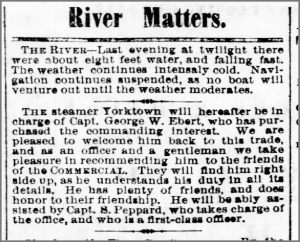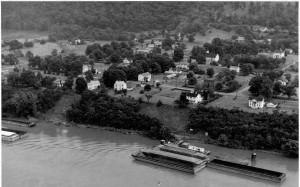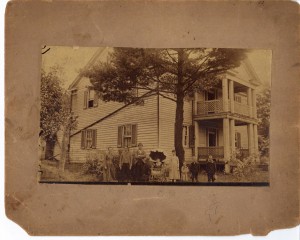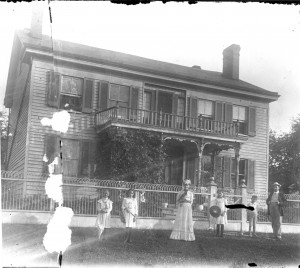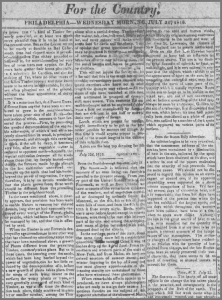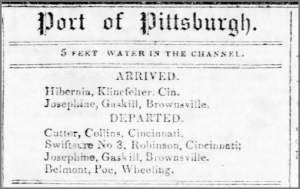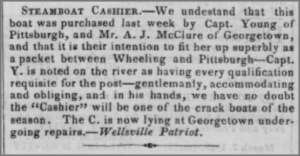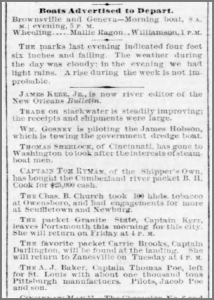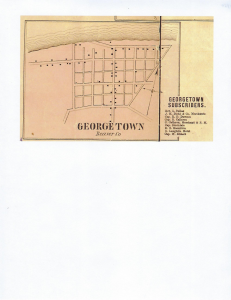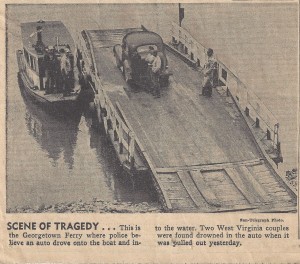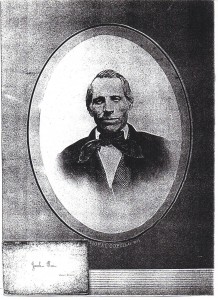
Jacob Poe with Str Belmont Card (Anna L and John F Nash Collection)
Few steamboatmen traveled farther or as wide-ranging or on as many rivers as Capt Jacob Poe. In 1837, Capt Jacob steamed to Olean, NY on the Allegheny River; in 1848 Chillicothe, OH on the Scioto River; in 1849 Ft Des Moines on the Des Moines River; in 1851 Warsaw MO on the Osage River; in 1854 Ft Riley on the Kansas River. During the Civil War, Capt Jacob Poe was transporting troops and supplies on the Red River, White River, Yazoo River, and of course the Tennessee and Cumberland Rivers. After the Civil War he was on the furious upper Missouri River making several trips to Ft Benton in the Montana Territory. He spent his life steaming on the sharp edge of a constantly moving American frontier. Few steamboatmen are gifted to read the waters of one river, fewer exceed the scope of Jacob Poe’s travels.
From the details available, Capt Jacob Poe was often described as the pilot. He seemed to favor work in the pilot house more than the packet management position of the master or captain. He preferred to read the waters rather than count the money. He not only drove the boats and shared their ownership with his brothers, he often watched over the construction of new family boats. No doubt his ideas were the foundation of the Poe favored mid-sized sternwheel design.
In 1837, Jacob Poe was hired for his first command – the captain and first pilot of the str Beaver No 2. That same year he was the pilot of the str New Castle which was one of two boats ever that went up the Allegheny River to Olean, NY.
Jacob Poe’s last US Inspection Certificate was dated 1 Dec 1890. It was his fifteenth masters license and thirty-second pilots license for the Ohio and Cumberland Rivers. In total, fifty-three years working on the Ohio River as a steamboat pilot. (The Steamboat Act of 1852 established in law for the first time, the license certification process for pilots, engineers, and vessels.)
The following table summarizes a few newsclips by date indicating that Jacob Poe was often employed as a pilot. His son, George WE Poe, quit business school in Pittsburgh to serve the Union during the Civil War as a cub pilot. After the Civil War, together the father and son team worked as pilots on some Poe family owned boats and other boats of business partners centered around Pittsburgh. Without certain proof, Jacob Poe was assisting the development of his son’s career on the river.
Steamboat officer: Pilot Jacob Poe
| Date |
Officer |
Steamer Name |
Destination |
Note |
|
|
|
|
|
|
| 13 Nov 1855 |
Master |
Clifton |
Nashville |
1
|
|
| 31 Oct 1864 |
Master |
Yorktown |
Cincinnati |
2
|
|
| 25 Jan 1869 |
Pilot |
Sallie |
Louisville |
3
|
|
| 01 May 1869 |
Pilot with son |
Argosy |
Cincinnati |
3
|
|
| 20 Jan 1871 |
Pilot with son |
Glencoe |
New Orleans |
3
|
|
| 23 Feb 1871 |
Pilot with son |
Silver Lake No4 |
Cincinnati |
3
|
|
| 02 Mar 1871 |
Pilot with son |
Brill |
Cincinnati |
3
|
|
| 09 Apr 1873 |
Pilot |
EH Dufee |
Ft Benton |
3
|
|
| 18 May 1874 |
Pilot |
AJ Baker |
St Louis |
2
|
|
| 15 Apr 1877 |
Pilot |
Carrie Brooks |
Zanesville |
4
|
|
| 26 Nov 1878 |
Master |
John D Sully |
New Orleans |
4
|
|
|
|
|
|
|
|
|
|
|
|
|
|
|
|
|
|
|
|
Notes:
1. The Pittsburgh Daily Post, p3
2. The Pittsburgh Daily Commercial, p4.
3. The Pittsburgh Weekly Gazette, p3.
4. The Pittsburgh Post Gazette, p3.
Copyright © 2020 Francis W Nash
All Rights Reserved
No part of this website may be reproduced without permission in writing from the author.
